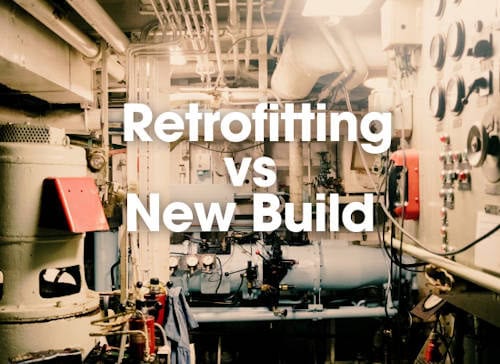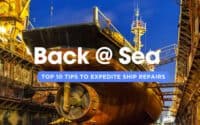Retrofitting Older Vessels vs. New Builds

In the maritime industry, shipowners face a critical decision when their vessels age: invest in new builds or retrofit existing ships. This choice impacts not only financial outlays but also operational efficiency and compliance with increasing environmental regulations. Below, we summarize the primary advantages and disadvantages of each option, helping owners make informed decisions based on their specific needs and future outlook.
* Please send feedback/suggestions to editor @ shipuniverse.com
Pros of New Builds:
- Enhanced Efficiency: Modern vessels are designed with the latest technologies for fuel efficiency and emissions reduction.
- Lower Operational Costs: Newer ships typically require less maintenance and are more reliable, reducing operational costs.
- Regulatory Compliance: Built to meet current and foreseeable regulations, avoiding retrofitting costs.
- Advanced Technology: Incorporates the latest in maritime tech, from navigation aids to automated systems.
Cons of New Builds:
- High Initial Investment: Significantly higher upfront costs compared to retrofitting.
- Potential Overcapacity: Risk of market fluctuations that may affect vessel profitability.
- Longer Lead Times: Construction and delivery of new ships can take several years.
Pros of Retrofitting:
- Cost-Effective: Generally lower immediate financial outlay than purchasing a new build.
- Extended Vessel Life: Allows older ships to remain competitive and compliant for several more years.
- Customization: Specific upgrades can be chosen based on the most critical needs and ROI.
Cons of Retrofitting:
- Limited Upgrades: Physical and design limitations may restrict the extent of improvements.
- Downtime: Significant retrofitting can take ships out of operation for extended periods.
- Decreasing Returns: Older vessels might still lag behind new builds in performance and efficiency, despite upgrades.
Let’s look at three example scenarios.
Scenario #1 New Cargo Ship vs 30 Year Old Vessel
Overview of the Vessel
- Type of Vessel: General Cargo Ship
- Age: 30 years
- Current Condition: Functional but below current environmental and efficiency standards
- Typical Routes: Trans-Atlantic and intra-Asia
Option 1: Retrofitting the 30-Year-Old Cargo Ship
Areas of Retrofitting:
- Engine and Propulsion System Upgrades
- Replace older engine components with modern, fuel-efficient systems.
- Install an exhaust gas cleaning system (scrubber) to meet emission standards.
- Hull Modifications
- Apply anti-fouling coatings to reduce drag.
- Modify the hull to improve hydrodynamics.
- Digital and Automation Enhancements
- Install automated navigation and operational systems to reduce crew dependency.
- Implement advanced cargo handling systems for quicker loading and unloading.
Costs:
- Engine and Propulsion Upgrades: $3 million
- Hull Modifications: $500,000
- Digital Enhancements: $1.5 million
- Total Retrofitting Cost: $5 million
Benefits:
- Fuel Efficiency: Improved by 20%, reducing operational costs.
- Emission Compliance: Meets current and anticipated regulations, avoiding potential fines.
- Operational Efficiency: Reduced crew and maintenance costs.
Areas of Concern:
- Structural Integrity: Even with upgrades, older vessels might face unexpected repairs.
- Resale Value: Limited improvement despite significant investment.
Option 2: Investing in a New Build Cargo Ship
Specifications:
- Fuel Type: Dual fuel (LNG and diesel)
- Built-in Digital Features: Fully automated systems for navigation and cargo handling.
- Environmental Compliance: Designed to exceed current emission standards.
Costs:
- Construction Cost: $25 million
Benefits:
- Operational Efficiency: Significantly lower operating costs due to modern technology.
- Long-Term Viability: Longer operational lifespan with fewer regulatory concerns.
- Market Value: Higher resale value and better charter rates.
Areas of Concern:
- Initial Investment: Substantially higher upfront costs.
- Market Fluctuations: Potential for overcapacity affecting new ship values.
Deciding between retrofitting an old cargo ship or investing in a new build depends heavily on the company’s financial health, operational needs, and long-term strategy. Retrofitting can be a cost-effective solution for extending the life of a ship with lower initial outlay, but it carries risks related to the vessel’s age and potential hidden costs. On the other hand, a new build, though costly, offers long-term savings and reliability. Each scenario should be evaluated based on specific operational profiles and market conditions.
Scenario #2 New RoRo Ship vs 30 Year Old Vessel
Overview of the Vessel
- Type of Vessel: RoRo Ship
- Age: 30 years
- Current Condition: Operational but not optimized for current logistical demands
- Typical Routes: European coastal service and Mediterranean crossings
Option 1: Retrofitting the 30-Year-Old RoRo Ship
Areas of Retrofitting:
- Ramp and Access Technology Upgrades
- Upgrade ramps and doors to facilitate faster loading and unloading.
- Improve hydraulic systems for enhanced reliability and speed.
- Engine and Propulsion System Enhancements
- Install a more efficient propulsion system to reduce fuel consumption.
- Retrofit SCR (Selective Catalytic Reduction) systems to reduce NOx emissions.
- Safety and Navigation Upgrades
- Implement advanced fire detection and suppression systems specific to vehicle carriers.
- Upgrade navigation systems to incorporate the latest GPS and AIS technology.
Costs:
- Ramp and Access Upgrades: $1.2 million
- Engine and Propulsion Enhancements: $2.8 million
- Safety and Navigation Upgrades: $600,000
- Total Retrofitting Cost: $4.6 million
Benefits:
- Loading Efficiency: Improved by 30%, reducing port time.
- Fuel and Emission Efficiency: 15% reduction in fuel usage and compliance with stricter emission standards.
- Safety and Compliance: Meets all current maritime safety regulations.
Areas of Concern:
- Downtime for Upgrades: Potential revenue loss during retrofitting period.
- Limitations of Existing Structure: Physical and design constraints may limit the extent of upgrades.
Option 2: Investing in a New Build RoRo Ship
Specifications:
- Design Innovations: State-of-the-art loading technology and optimized hull design.
- Environmental Standards: LNG-powered engines to significantly reduce emissions.
- Technology Integration: Fully integrated digital systems for operations and crew management.
Costs:
- Construction Cost: $45 million
Benefits:
- Operational Efficiency: 50% increase in loading speed and 20% reduction in crew needed.
- Environmental Impact: Meets and exceeds future environmental regulations.
- Adaptability: Designed to adapt to changing regulations and market demands.
Areas of Concern:
- High Capital Investment: Significant initial expenditure.
- Economic Sensitivity: High dependence on global economic stability and trade flows.
For RoRo ship owners, the choice between retrofitting an older vessel and investing in a new build involves balancing immediate cost implications against long-term operational benefits. While retrofitting offers a less costly alternative in the short term with substantial improvements, investing in a new build could provide greater efficiencies and market competitiveness over decades. Strategic considerations should focus on operational demands, market conditions, and the projected lifespan of the vessel.
Scenario #3 New Tanker Ship vs 30 Year Old Vessel
Overview of the Vessel
- Type of Vessel: Crude Oil Tanker
- Age: 30 years
- Current Condition: Operational but facing increasing maintenance and compliance costs
- Typical Routes: Transatlantic and Gulf routes to European and North American ports
Option 1: Retrofitting the 30-Year-Old Tanker Ship
Areas of Retrofitting:
- Tank and Structural Enhancements
- Upgrade tank coatings to latest standards to prevent corrosion and contamination.
- Strengthen hull structure to extend service life and meet new safety standards.
- Emission Control Systems
- Install Advanced Air Pollution Control Systems such as scrubbers and catalytic converters.
- Retrofit vapor recovery systems for loading and unloading operations.
- Energy Efficiency Improvements
- Upgrade to more efficient boiler systems and incorporate waste heat recovery.
- Implement fuel optimization software to manage and reduce fuel consumption.
Costs:
- Tank and Structural Enhancements: $2 million
- Emission Control Systems: $3 million
- Energy Efficiency Improvements: $1 million
- Total Retrofitting Cost: $6 million
Benefits:
- Regulatory Compliance: Ensures compliance with the latest MARPOL Annex VI requirements.
- Operational Cost Reduction: Decreases in fuel and maintenance costs by up to 20%.
- Cargo Integrity: Enhanced tank integrity reduces risks of cargo contamination.
Areas of Concern:
- Operational Downtime: Necessary upgrades could take the vessel out of commission for several months.
- Future Viability: Even with upgrades, older tankers may not compete with newer, more advanced ships.
Option 2: Investing in a New Build Tanker Ship
Specifications:
- Advanced Materials: Use of lightweight, corrosion-resistant materials in construction.
- Latest Environmental Technology: LNG propulsion systems and on-board CO2 capture technologies.
- Enhanced Cargo Systems: State-of-the-art cargo handling and monitoring systems for safer and faster operations.
Costs:
- Construction Cost: $70 million
Benefits:
- Long-term Operational Savings: Highly efficient operations reduce overall running costs.
- Environmental Footprint: Meets future environmental regulations comfortably.
- Technology Advantage: Incorporates the latest navigational and operational safety technologies.
Areas of Concern:
- Large Capital Outlay: Requires substantial upfront investment.
- Market Adaptability: New technologies may require adaptation to future regulatory changes.
Deciding whether to retrofit or invest in a new tanker involves assessing not just the financial costs but also the operational strategies and long-term market expectations. Retrofitting an old tanker can be a cost-effective measure to extend its operational life and meet current standards. However, a new build offers long-term benefits, including superior efficiency, compliance, and competitiveness in a rapidly evolving market.

Do you have a Maritime Product or Service that may be of interest to Shipowners? Tell us about it here!
Do you have feedback or insights? Please reach out to editor @ shipuniverse.com



